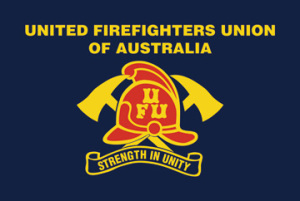I acknowledge the Ngunnawal and Ngambri peoples as the traditional owners and custodians of the Canberra area and pay respect to the elders, past and present, of all Australia’s Indigenous peoples.
When talking about fire, acknowledgement of country and people takes on a special resonance. The effective utilisation of fire by Indigenous peoples to shape this country is well documented.
We are here today to call on Governments Work collaboratively in the interests of firefighter and community safety to:
- Address issues of compatibility and capacity to facilitate the most
effective interoperability of emergency service organisations and their
key personnel, especially for fire services. - Build greater capacity to fight fires nationally. That includes increasing
the number of firefighters by at least two thirds by 2030. - Reduce emissions by rapidly phasing out the burning of coal oil and gas which is driving more dangerous fires and accelerating the transition to renewables and storage technologies, and non-polluting transport, infrastructure, and food production. It is now that we need the Federal Government to step up to protect Australian lives from worsening disasters in the future.
These initiatives should be facilitated by the establishment of a subject
matter expert committee operating at a Federal level to audit the
progression of recommendations of Senate Inquiries and other bodies, with
a view to expediting coordinated and decisive action.
This week we, representatives of career firefighters across Australia have been meeting in Canberra to set out our priorities and directions for the next year. We are joined in that endeavor by our dear colleagues from the New Zealand Professional Firefighters Union, and we have been addressed by representatives of our global alliance partners the International Association of Firefighters.
Obviously, we could not meet without addressing the widespread, devastating and unprecedented fires that burn right now across Australia, and most obviously along the great divide and eastern seaboard.
We say to those who are affected by these fires that you have much more than our sympathy. While our members serve you in your hours of greatest need, you have our commitment to fight for additional resources, policies and actions to bring greater protection from these fires, and address some of the factors which make them worse.
We recognize the recent findings of the Climate Council’s studies, including that released 2 days ago, specifically:
- The catastrophic, unprecedented fire conditions currently affecting NSW and
Queensland have been aggravated by climate change; - Bushfire conditions are now more dangerous than in the past;
- The fire season has lengthened so substantially that it has already reduced opportunities for fuel reduction burning;
- The costs of fighting fires are increasing;
- Australia is being battered by extreme weather events, made worse by climate change. The summer of 2019/20 is shaping up as another terrible trifecta of heatwaves, droughts and bushfires;
- Climate change is making many extreme weather events in Australia worse;
- Worsening extreme events, such as heatwaves, drought and bushfires, are affecting the health and well-being of Australians and important sectors such as farming;
- The catastrophic events that are unfolding in Australia are not “normal”. Now is the time to act decisively and swiftly;
- The government must develop an urgent plan to (1) prepare Australian communities, health and emergency services for escalating fire danger; and (2) rapidly phase out the burning of coal oil and gas which is driving more dangerous fires.
We are experiencing not only increased bushfire risk, but also more extreme weather events which place an increased demand on emergency services including fire and rescue services. For example, ferocious winds rapidly fan flames, shift fire fronts and ground firefighting aircraft, all combining to make fires more dangerous and more difficult to fight.
The longer fire seasons, the increasingly unpredictable and changeable weather conditions, the hotter temperatures and lower rainfall all combine to increase the challenges that firefighters face on the fireground.
There are 2 things about firefighters and firefighting that need to be said. The first is, that our members have a philosophy of “leaving the job in better shape than they found it”. The second is, that on their worst day, firefighters still give 100% effort and performance, because if they don’t it is certain that people will die.
Our politicians would do well to match the effort and commitment of firefighters in addressing the very real escalation of fire risks and the very real pain and loss that communities now face. The problems facing our political leaders require that, like firefighters, they give 100% commitment to leaving things better than they found them.
We have been pointing to these problems for some time, and they’ve been getting worse.
In 1994 in New South Wales alone, fires which were then considered a national disaster burnt over 800,000 hectares and destroyed 225 houses. This led to the formation of the Rural Fire Service.
Just days ago, the NSW RFS reported that 7,300 bush and grass fires had destroyed over 2 million hectares of land, 673 homes, and 1,400 other buildings, and taken the lives of 6 people.
Locally, In January 2003, 160,000 hectares (almost 70%) of the A.C.T and a further 100,000 hectares in neighbouring N.S.W were burnt in devastating bushfires.
In 2013, a study by undertaken by the National Institute of Economic and Industry Research, found that to deal with climate related increased bushfire risks, Australia will need to increase the number of firefighters by between 67% and 83% by 2030. The same study concluded that the A.C.T will need to increase the number of firefighters by between 75% and 96% over the same period: almost double the current number.
In 2014 A study by the climate council in found that Heatwaves are hotter, longer and more often, and hot days in Australia have doubled in the last 50 years. (Climate Council 2014)
In recent weeks 23 former fire chiefs united to bring this message to the fore:
“It’s exactly as we predicted.”
“We’ve seen records broken and the word ‘unprecedented’ used on many occasions,” he said.
“Fires are literally off the scale in fire danger in this warming planet.
“This is showing how climate change is supercharging the bushfire problem in Australia, and internationally.”
I would observe that when you have former fire chiefs and the union representing firefighters as one on this issue, it gives great weight to the compelling message on climate change and fires and emergencies.
We say to Commonwealth, State and Territory Governments today, this is what you must do, and you must do this now:
Work collaboratively in the interests of firefighter and community safety to:
- Address issues of compatibility and capacity to facilitate the most
effective interoperability of emergency service organisations and their
key personnel, especially for fire services. - Build greater capacity to fight fires nationally. That includes increasing
the number of firefighters by at least two thirds by 2030. - Reduce emissions by rapidly phasing out the burning of coal oil and gas which is driving more dangerous fires and accelerating the transition to renewables and storage technologies, and non-polluting transport, infrastructure, and food production. It is now that we need the Federal Government to step up to protect Australian lives from worsening disasters in the future.
These initiatives should be facilitated by the establishment of a subject
matter expert committee operating at a Federal level to audit the
progression of recommendations of Senate Inquiries and other bodies, with
a view to expediting coordinated and decisive action.
To those who for whatever reason do not agree with what we have to say about the impact of climate change on fires, we say this:
The things we are urging be done will not hurt you. They will help you. Please listen to us – we are listening to you, and our members are serving you in your moments of greatest need. Please, help us to help you.
As each day passes, decisive action becomes more urgent. Our members see first hand the devastation that is being caused. There are no climate sceptics on the end of a fire hose.
Thank you.
For questions:
In 2017, the National Aerial Firefighting Centre (NAFC), sent a proposal on behalf of all states and territories to Canberra for an annual increase of $11 million above its existing $15 million in funding, but they still do not have an answer. Now while Aerial firefighting craft are highly important, they are not the only answer: with the Queensland fires several weeks ago we saw such aircraft grounded by extreme winds.
Extreme weather examples
Some examples of that extreme weather are:
- May 2018: NSW Hunter Valley gets snow and bushfires on same night https://www.triplem.com.au/story/hunter-gets-snow-bushfire-in-the-same-night-93554
- September 2018 Snowy Mountains highway closed at one end due to bushfire and nearly shut down at the other following snow https://www.theguardian.com/australia-news/2018/sep/16/fire-snow-and-100kmh-winds-nsw-battered-by-extreme-and-dangerous-weather.
- March 2019: Mt Baw Baw Victoria experienced snow within days of its hottest day ever, while bushfires led to evacuations https://www.abc.net.au/news/2019-03-06/bushfires-snow-week-at-victorias-mount-baw-baw/10877164
- August 2019: This summer, over 600 wildfires have consumed more than 2.4 million acres of forest across Alaska. http://theconversation.com/huge-wildfires-in-the-arctic-and-far-north-send-a-planetary-warning-121167

